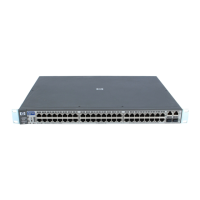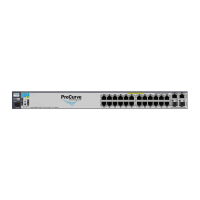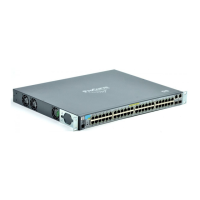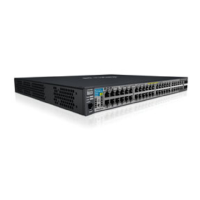11-3
Port-Based Virtual LANs (VLANs) and GVRP
Port-Based Virtual LANs (Static VLANs)
Port-Based Virtual LANs (Static VLANs)
VLAN Features
A VLAN is a group of ports designated by the switch as belonging to the same
broadcast domain. (That is, all ports carrying traffic for a particular subnet
address would normally belong to the same VLAN.)
Note This section describes static VLANs, which are VLANs you manually configure
with a name, VLAN ID (VID), and port assignments. (For information on
dynamic VLANs, see “GVRP” on page 11-33.)
Using a VLAN, you can group users by logical function instead of physical
location. This helps to control bandwidth usage by allowing you to group high-
bandwidth users on low-traffic segments and to organize users from different
LAN segments according to their need for common resources.
By default, on the Switches 2650 and 6108, 802.1Q VLAN support is enabled.
They allow up to 30 port-based VLANs (default: 8). (The 802.1Q compatibility
enables you to assign each switch port to multiple VLANs, if needed, and the
port-based nature of the configuration allows interoperation with older
switches that require a separate port for each VLAN.)
General Use and Operation. Port-based VLANs are typically used to
reduce broadcast traffic and to increase security. A group of network users
assigned to a VLAN forms a broadcast domain that is separate from other
VLANs that may be configured on a switch. On a given switch, packets are
forwarded only between ports that are designated for the same VLAN. Thus,
all ports carrying traffic for a particular subnet address should be configured
to the same VLAN. Cross-domain broadcast traffic in the switch is eliminated
and bandwidth is saved by not allowing packets to flood out all ports. An
external router is required to enable separate VLANs on a switch to commu-
nicate with each other.
Feature Default Menu CLI Web
view existing VLANs n/a page 11-10
thru 11-15
page 11-16 page 11-21
configuring static
VLANs
default VLAN with
VID = 1
page 11-10
thru 11-15
page 11-15 page 11-21
configuring dynamic
VLANs
disabled See “GVRP” on page 11-33.
!Software.book Page 3 Thursday, October 10, 2002 6:10 PM

